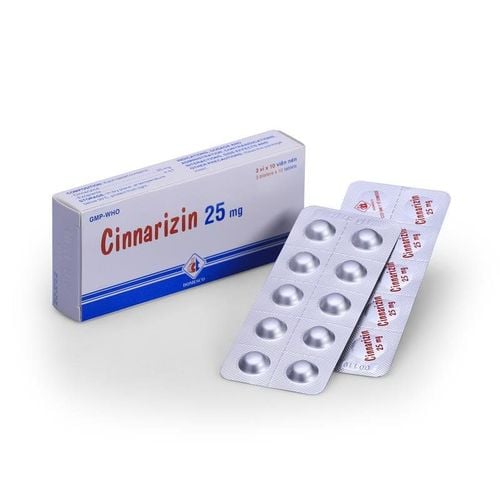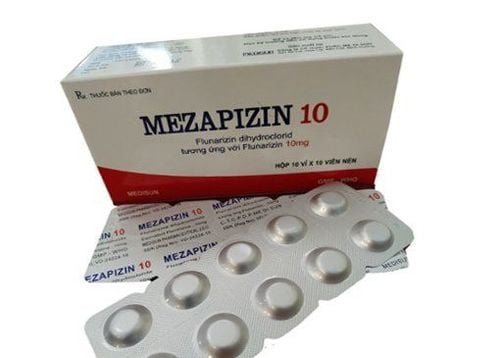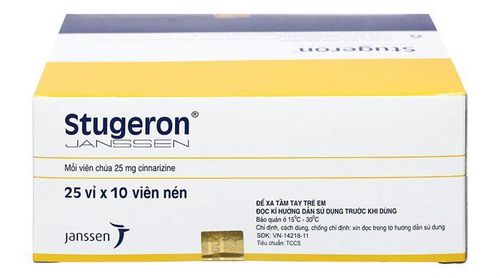This is an automatically translated article.
Fluostine 5mg is a medicine used in the treatment of migraine and vestibular disorders. So how should Fluostine be taken? What precautions should be taken when using this drug? Let's find out the necessary information about the drug Fluostine 5mg through the article below.
1. Uses of Fluostine 5mg
The drug prevents cellular calcium overload, by reducing excessive calcium influx across cell membranes. Flunarizine has no effect on myocardial contractility and conduction.
1.1 Indications Prophylaxis of migraine Symptomatic treatment of vestibular vertigo due to vestibular system dysfunction. Treatment of symptoms caused by cerebral circulatory insufficiency and brain cell hypoxia including: dizziness, headache of vascular origin, arousal disorder, memory loss, poor concentration and sleep disturbance. 1.2 How to take - Dosage of Fluostine 5Mg How to use:
Because of the risk of drowsiness, it is better to take it at night before going to bed.
Dosage:
Adults ≤ 65 years old and elderly people (> 65 years old):
5 mg/day, taken in the evening, maintained for 4 to 8 weeks. During treatment, if depressive, extrapyramidal or other serious adverse events occur, the drug should be discontinued. If there is no improvement after 8 weeks of treatment, the patient is considered unresponsive to treatment and the drug should be discontinued. The duration of treatment should not exceed 6 months. Recommendations only for patients <65 years of age: If the patient's clinical presentation indicates an inadequate response to treatment, this may be increased to 10 mg/day but should be considered in the patient's tolerability profile. . Children:
Children ≥ 12 years old, especially in case of undiagnosed migraine: 5mg/day, taken in the evening. The duration of treatment should not exceed 6 months. Children < 12 years: There is no adequate evidence on the efficacy and safety of flunarizine in this population. Flunarizine is not recommended for use in children under 12 years of age. Note: The above dosage is for reference only. The specific dose depends on the condition and the progression of the disease. To get the right dose, you need to consult your doctor or healthcare professional.
1.3 Overdose - missed dose and management Overdose:
Symptoms: a few cases of acute overdose (doses over 600 mg) have been reported. The main symptoms are drowsiness, tachycardia, agitation.
Treatment: use activated charcoal, treat symptoms. There is no specific antidote.
Actively follow up to take timely measures.
Missed dose:
If you miss a dose, take it as soon as possible. However, if it is almost time for your next dose, skip the missed dose and take your next dose at the scheduled time. Note that double the prescribed dose should not be taken.
2. Fluostine 5Mg . Side Effects
Nervous system side effects: fatigue, drowsiness, anxiety Digestive side effects: increased appetite leading to weight gain, vomiting, stomach pain Other side effects: movement disorders, Depression, rash,... During treatment, if the patient notices any unusual symptoms that are suspected to be due to the use of the drug, the patient should consult a pharmacist or treating doctor. for timely and accurate treatment.
3. Notes when using Fluostine 5Mg
Contraindications:
Fluostine is contraindicated in the following cases:
Hypersensitivity to flunarizine or any of the excipients of the drug. Have symptoms of Parkinson's disease since before treatment. History of extrapyramidal symptoms. Depression or history of recurrent depressive syndrome. Note
Precautions for use:
Flunarizine can cause depressive symptoms, extrapyramidal manifestations and Parkinson's syndrome, especially in the elderly. Therefore, the drug should be used with caution in this population. Do not use more than the recommended dose. It is necessary to monitor patients regularly and periodically, especially during maintenance therapy to detect extrapyramidal symptoms, depression and stop treatment in time. The time to onset of extrapyramidal syndrome may be slow (about 1 year). This condition is usually not serious but can persist for several months after stopping the medication (median recovery time is 3 months). Recovery may not be complete, and pharmacological treatment of Parkinson's may be necessary. In some cases, symptoms may persist despite treatment. Cases of depression are frequently reported. This condition, which appears after 5 to 8 months of taking the drug, is usually not serious. In some cases, antidepressant use and/or hospitalization is considered necessary for the patient. Flunarizine may cause weight gain. Some cases of fatigue with increasing severity have been reported with flunarizine use. If this occurs, treatment with flunarizine should be discontinued. The drug contains lactose hydrate, so patients with galactose intolerance, lactase deficiency or glucose-galactose malabsorption should not take this medicine. Ability to drive and use machines
Particular attention should be paid to the risk of drowsiness, especially when driving and operating machines, when starting treatment.
Pregnancy
There is no evidence of a teratogenic effect in animals, not expected in humans. In fact, compounds believed to be teratogenic in humans have now been shown to have teratogenic effects in two animal species in well-conducted studies. Therefore, as a precaution, it is better to avoid administering flunarizine to pregnant women.
Lactation
It is not known whether flunarizine is excreted in human milk. Animal studies have shown that flunarizine is excreted in milk. The decision to discontinue nursing or to continue/discontinue treatment with flunarizine must be based on the benefit of breast milk to the infant relative to the benefit of treatment to the mother.
4. Drug interactions
Combinations to avoid
Alcohol Increases the drowsiness effect of alcohol. Reduced alertness can be dangerous while driving or operating machinery. Avoid alcoholic beverages and drugs containing alcohol.
Combinations to be noted
Drugs with atropinic effect It should be noted that atropinic active ingredients can enhance their undesirable effects and easily cause urinary retention, acute exacerbation of glaucom, constipation, dry mouth ,...
Other atropinic drugs may be antidepressants of the imipramine class, most atropinic H1 antihistamines, anticholinergic Parkinson's drugs, atropinic antispasmodics, disopyramide, drugs. phenothiazines and clozapine groups.
Sedatives It should be noted that many active substances can enhance CNS depression and contribute to decreased alertness. These are morphine derivatives (analgesics, cough suppressants and anti-addiction therapy), psychotropic drugs, benzodiazepines, anxiolytics other than benzodiazepines (such as meprobamate), tranquilizers, hypnotic antidepressants (amitriptyline, doxepin, mianserin, mirtazapine, trimipramine), sedating H1 antihistamines, CNS-acting antihypertensives, baclofen and thalidomide.
Other cases
Topiramate The pharmacokinetics of flunarizine is not affected by topiramate. When flunarizine was used in combination with topiramate at a dose of 50 mg every 12 hours, a 16% increase in flunarizine blood levels was observed in migraine patients compared with 14% in patients receiving flunarizine alone. Flunarizine has no effect on the pharmacokinetics of topiramate at steady state.
Please dial HOTLINE for more information or register for an appointment HERE. Download MyVinmec app to make appointments faster and to manage your bookings easily.













